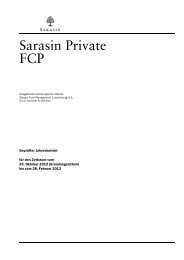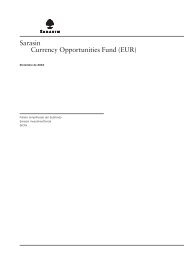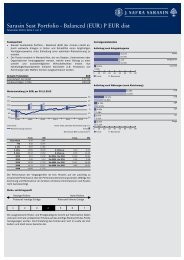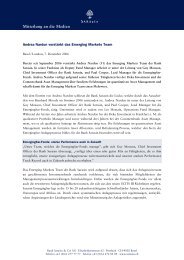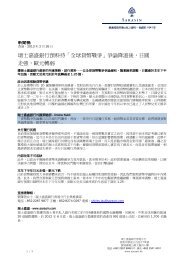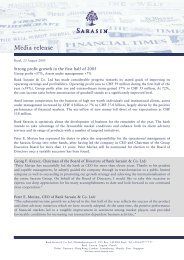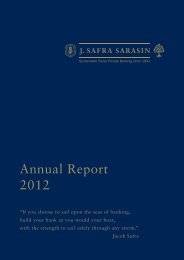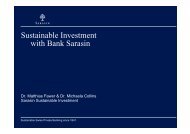Annual Report 2012 - Bank Sarasin
Annual Report 2012 - Bank Sarasin
Annual Report 2012 - Bank Sarasin
You also want an ePaper? Increase the reach of your titles
YUMPU automatically turns print PDFs into web optimized ePapers that Google loves.
5. Risk management<br />
Structure of risk management<br />
General considerations<br />
Assessing and taking risks is in the nature<br />
of banking. For this reason, a clearly<br />
defined, transparent and integrated risk<br />
management policy is adopted for all<br />
divisions and is adapted continuously to<br />
the latest knowledge. Substantial human<br />
and technological resources are made<br />
available for this purpose. Active risk<br />
management should make it possible to<br />
minimise undesirable risks and to make<br />
optimum use of the <strong>Bank</strong>’s capital for the<br />
benefit of all shareholders. The change of<br />
majority shareholder from Rabobank to J.<br />
Safra <strong>Sarasin</strong> Holding Ltd also had a<br />
major impact on risk controlling and<br />
limitation, especially with respect to the<br />
market, credit and liquidity risks.<br />
Risk culture<br />
The standard of risk management<br />
achieved by a financial institution is not<br />
simply a question of compliance with<br />
formalised internal and external rules. Of<br />
equal, if not even greater, significance is<br />
the risk awareness of decision-makers.<br />
The quantitative criteria on which attention<br />
frequently centres are only one component<br />
of a comprehensive risk management<br />
system. The development of an<br />
appropriate risk culture as part of a<br />
financial institution’s overall culture is just<br />
as important. A central element of such a<br />
risk culture is the discipline and<br />
thoroughness with which participants<br />
respond to their tasks in the risk<br />
management process. Integrity, risk<br />
awareness on the part of everyone<br />
concerned at all levels of <strong>Bank</strong> <strong>Sarasin</strong> as<br />
well as clearly defined responsibilities and<br />
competencies are the pillars that support<br />
<strong>Sarasin</strong>’s risk culture.<br />
Organisation of risk management<br />
The Board of Directors has performed<br />
adequate and regular risk assessments<br />
and introduced any remedial measures<br />
required to minimise the risk of material<br />
misstatement in the financial statements<br />
as far as possible.<br />
Furthermore the Board of Directors is<br />
responsible for the formulation and<br />
implementation of the Group’s risk policy.<br />
It lays down the risk strategy, the<br />
organisational framework for risk<br />
management such as limits and systems,<br />
the maximum risk tolerance and<br />
respective responsibilities. The risk policy<br />
is reviewed annually to ensure its<br />
appropriateness.<br />
The CEO and the Executive Committee are<br />
responsible for implementing the risk<br />
management and risk controlling<br />
principles approved by the Board of<br />
Directors. They are supported by the<br />
various committees. The Risk Committee<br />
carries out a comprehensive assessment<br />
of all the <strong>Bank</strong>'s principal risks, both<br />
current and those anticipated in future.<br />
The CFO chairs the Risk Committee,<br />
whose members include the CEO, the<br />
division heads for Trading & Family<br />
Offices, Asset Management, Products &<br />
Sales and Logistics, the market heads for<br />
the Middle East and Asia, and the heads<br />
of the Risk Office and Legal &<br />
Compliance. When evaluating risk, it takes<br />
into consideration the findings and<br />
measures of the other committees. The<br />
Central Credit Committee (CCC) is in<br />
charge of managing counterparty risk. The<br />
Treasury Committee controls and<br />
manages interest rate risk, short-term<br />
liquidity risk and mid to long-term<br />
refinancing risk throughout the Group on<br />
an operating basis.<br />
During the course of the fourth quarter a<br />
new body, the Investment Committee, was<br />
set up to deal with the strategic aspects<br />
of balance sheet management. The tasks<br />
of this committee also include assessing<br />
counterparty risks resulting from the<br />
Treasury Bond Portfolio. This committee is<br />
composed of top divisional management<br />
and staff from the various specialist areas<br />
concerned and meet at regular intervals.<br />
The Risk Committee and the Central<br />
<strong>Bank</strong> <strong>Sarasin</strong> & Co. Ltd, <strong>Annual</strong> <strong>Report</strong> <strong>2012</strong> | 64



